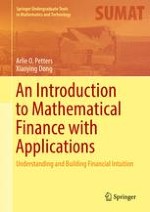2016 | OriginalPaper | Chapter
2. The Time Value of Money
Authors : Arlie O. Petters, Xiaoying Dong
Published in: An Introduction to Mathematical Finance with Applications
Publisher: Springer New York
Activate our intelligent search to find suitable subject content or patents.
Select sections of text to find matching patents with Artificial Intelligence. powered by
Select sections of text to find additional relevant content using AI-assisted search. powered by
